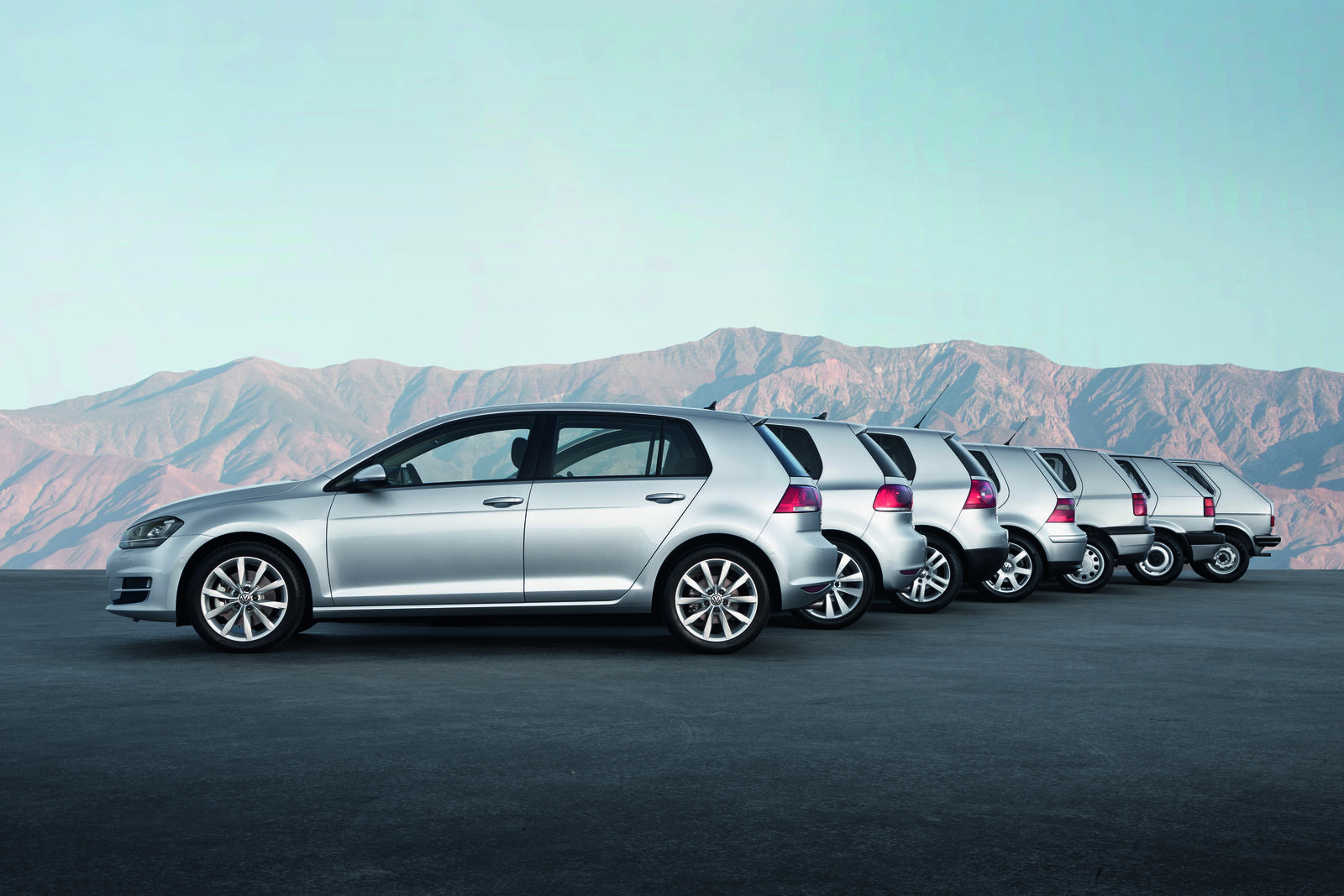Key aspects
40 Years of Golf
40 years of Golf – Volkswagen is celebrating its icon
Best-seller – the Golf was built more than 30 million times until now
Trendsetter – the Golf democratised safety, sportiness and sustainability
Volkswagen is celebrating the 40th birthday of the most successful European car of all time: the Golf. To this very day, more than 30 million vehicles of the best-seller have been sold. From day one, the Golf has reflected technological progress. Whether turbo engine, direct-injection engine, electric or plug-in hybrid drive system; whether ABS, ESC, XDS or 4MOTION; whether Adaptive Cruise Control, City Emergency Braking, trailer stabilisation or Automatic Post-Collision Braking System; whether automatic air conditioning, Dynaudio sound system, touchscreen with proximity sensor or LED headlights; whether Trendline, Comfortline, Highline, GTI, GTD or GTE – it was always the Golf through which the most important technologies and trends of our time were democratised.
Golf I. The first production Golf rolled off the assembly line in Wolfsburg on 29 March 1974 and was available at the Volkswagen dealers from May onwards. Where for decades the Beetle and thus rear-mounted engines and rear-wheel drive had dominated the scene, a new era had now dawned: that of the transversely mounted front engine and front-wheel drive. This trend had been heralded a short time earlier by the Scirocco and – as the first Volkswagen front-wheel drive car, following the K70 that was taken over from NSU – the Passat, introduced in 1973. With the launch of the Golf, the highest volume vehicle category had now also been switched to the new technology.
As the successor to the legendary Beetle, of which over 21.5 million units were built, the Golf I, designed by Giorgio Giugiaro and Volkswagen Design, had to live up to the immense expectations that it would carry on the success story of what until then was the world's most successful car. It worked: The modern and reliable drive concept, the excellent spatial economy and ultimately the design as well, won over the market to such an extent that production of the one-millionth Golf was already being celebrated in October 1976.
Like every Golf that would appear after it, the first generation, too, reflected the progress and automotive trends. In launching the first Golf GTI (in 1976), Volkswagen heralded the introduction of greater dynamism in this class, while the Golf D (naturally aspirated diesel engine, 1976) and the later Golf GTD (turbodiesel, 1982) marked the breakthrough for diesel cars in the compact segment. With the Golf Cabriolet, introduced in 1979, Volkswagen launched an open car on the market that was at times the best-selling open car in the world. 6.99 million vehicles of the first generation Golf, including all derivatives such as the convertible and the Jetta (at that time structurally identical), were sold – 0.87 million Golf cars per year.
Golf II. It was the second generation Golf that was the Volkswagen in which the baby-boomer generation, people who are now in their fifties and sixties, learned to drive. While its predecessor had already become a favourite of all driving instructors and learner drivers, the second Golf had now become firmly and inerasably established in the minds of these temporary allies. As of August 1983, they no longer sat quite so close to each other, since spatial utilisation had been improved once more. As a matter of fact: it was the Golf that introduced the regulated catalytic converter (1984), anti-lock braking system (ABS, 1986) and power-steering to the Golf class and that could be ordered with an all-wheel drive system for the first time (Syncro, 1986). And as far back as 1989, Volkswagen was already unveiling a prototype of this Golf with an electric drive system and another with a hybrid drive system. Including all derivatives, a total of 6.3 million second generation units were produced by the summer of 1991 – that is, 0.79 million Golf cars annually.
Golf III. With the launch of the third generation of the Golf in August 1991, Volkswagen heralded a new era of safety. The Golf III was the first of the series to have front airbags, starting in 1992, while major advances in the area of car body construction also resulted in significantly improved crash safety. In addition, numerous other technological milestones of the model range are linked to the third Golf. Many new features made their debuts in this new Golf: the first six cylinder engine (VR6), cruise control, oxidation catalytic converter for diesel engines (1991), the first direct injection diesel engines (TDI in 1993 and SDI in 1995) and side airbags (1996). Likewise, ABS became a standard feature on all Golf models in 1996. In 1993, Volkswagen had also introduced a new convertible based on the Golf III, a new all-wheel drive model (Syncro II) and the first Golf Variant (an estate). The third generation ended in 1997. Including all derivatives, a total of 4.83 million third generation units were produced, or 0.81 million per year.
Golf IV. Under the direction of Hartmut Warkuß, then Head of Design at Volkswagen (Group), the clear, precise design emerged for the Golf VI that did justice to the history of the Volkswagen brand more than ever before while setting its course to the future. It is in this era that the Volkswagen design DNA has its origins. With the debut of ESC (in 1998), the car continued to democratise safety. Also in 1998, Volkswagen unveiled the first all-wheel Golf with a Haldex clutch – the Golf 4MOTION. One year later, ESC became a standard feature, initially in Germany. The first direct-injection engine (FSI) and the debut of the standard head airbag (window airbags) followed in 2002. Also in 2002, Volkswagen launched the R32, with a top speed of 250 km/h. It was this top model of the range that in 2003 was the first to debut with the revolutionary dual-clutch gearbox (DSG). In the same year, the fully galvanised Golf IV made way on the production lines for the Golf V. Including all derivatives, a total of 4.99 million fourth generation units were produced – that is, 0.83 million Golf cars annually.
Golf V. This was the Golf that boasted levels of comfort and dynamic performance that left many a competitor in its class way behind in 2003. The same went for the car's quality. One factor that underlines the stability of the laser-welded bodywork was the 35 percent increase in torsion rigidity demonstrated when the Golf V made its debut in 2003. On request, the Golf was now also available for the first time with side airbags – together with the six standard airbags (front, side front and window) there were thus eight protective air buffers on board. In terms of comfort as well as dynamic performance, the Golf V scored in numerous areas, including: its new four-link rear suspension, seven-speed DSG, bi-xenon headlights, rain sensor and panoramic sliding sunroof, plus the debut of the first turbocharged direct injection petrol engine in the Golf GTI (in 2004) and the world's first twincharger (in the 2006 TSI), combining turbo- and supercharger. In 2006, the Golf Plus had its debut; in 2007, the CrossGolf, a new Estate and the extremely fuel-efficient Golf BlueMotion (4.5 l/100 km). Including all derivatives, a total of 3.4 million fifth generation units were produced - that is, 0.68 million Golf cars annually.
Golf VI. In just four years, a further 2.85 million Golf cars had been produced by the end of July 2012, based on the sixth generation of the car launched in 2008. And once again safety made great advances too: the car body was so rugged that it passed the EuroNCAP crash test with flying colours, gaining the maximum five stars. There was now also a further airbag fitted as standard: the knee airbag for the driver. Meanwhile, more TSI engines and a transition among the turbodiesel engines (TDI) from unit injection to the common rail system resulted in greater dynamic performance and lower fuel consumption. A top performer in the latter discipline was the second Golf BlueMotion with a combined fuel consumption of just 3.8 l/100 km, equivalent to 99 g/km CO₂. New assistance systems - such as Light Assist automatic main beam management, Park Assist, hill start assistant and technologies such as DCC dynamic chassis control - made the sixth generation the most advanced Golf to date. Including all derivatives, a total of 2.85 million sixth generation units were produced - that is, 0.71 million Golf cars annually.
Golf VII. On 4 September 2012, Volkswagen celebrated the world premiere of the seventh Golf. Just one day later, advance sales of the car, a best-seller, began in initial launch countries. Just three weeks later, Volkswagen presented the Golf for the first time to a large audience at the Paris Motor Show. The weight of the new Golf was reduced by up to 100 kg, thereby reversing the often cited upward weight spiral. Fuel economy was improved by a maximum of 23 percent, depending on engine selection. The new Golf TDI BlueMotion consumes only 3.2 l/100 km (equivalent to 85 g of CO₂/km) under standard NEDC conditions. Another innovation is the 1.4 TSI with 103 kW / 140 PS and automatic cylinder shut-off (ACT: active cylinder management). The combined fuel consumption of this petrol engine that is as sporty as it is sustainable: 4.7 l/100 km. In addition, Volkswagen has equipped the Golf with an entire armada of new assistance systems on the market – some as options and others as standard. In 2014, Volkswagen has electrified the compact class with the Golf: the all-electric e-Golf with a range of around 190 kilometres is already available to buy. In addition, the new Golf GTE will be launched in the autumn. Its plug-in hybrid drive system achieves a standard fuel consumption of 1.5 l/100 km; in all-electric mode, the Golf GTE can be driven for 50 kilometres.
Notes:
TDI, TSI and DSG are registered trademarks of Volkswagen AG or other companies of the Volkswagen Group in Germany and other countries.
Features and technical data apply to models offered in Germany. They may differ in other countries.
Media contact

